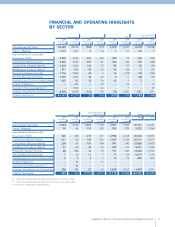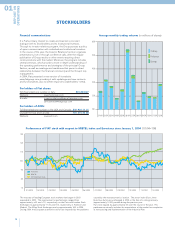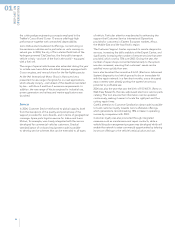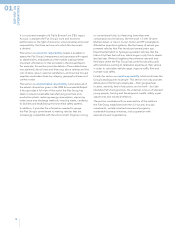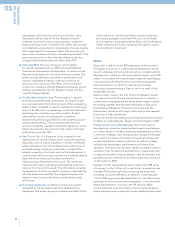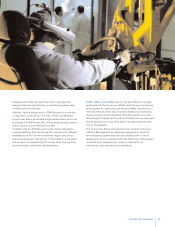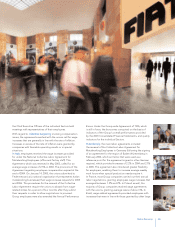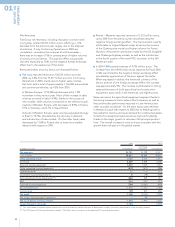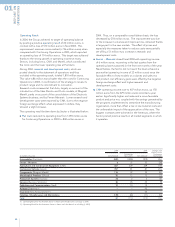Chrysler 2004 Annual Report Download - page 22
Download and view the complete annual report
Please find page 22 of the 2004 Chrysler annual report below. You can navigate through the pages in the report by either clicking on the pages listed below, or by using the keyword search tool below to find specific information within the annual report.
gas engines, which recently went into production, were
developed with the help of the Fiat Research Center’s
extensive know-how in natural gas propulsion systems for
buses and heavy trucks. Compared with earlier electronically-
controlled natural gas injection powerplants, the new engines
offer higher specific horsepower, better fuel economy and
hence lower emissions of carbon dioxide and pollutants. Their
emissions are so low, in fact, that they already satisfy the
stringent limits that will come into effect after 2010.
■Enhanced AMT.This new driveaway control system
for vehicles equipped with an AMT Automated Manual
Transmission was applied last September to versions of the
Maserati Quattroporte for the North American market. The
system ensures maximum acceleration performance and
smooth, repeatable driveaway under all conditions by
reducing clutch losses and the effects of environmental
conditions. It employs a Model Reference driveaway control
strategy developed by the Fiat Research Center and fine-
tuned by Magneti Marelli.
■Double-sheet Hydroforming.This procedure is capable
of producing double-shell components of complex shape
in a single operation. Hydroforming pairs of flat overlapping
sheets makes it possible to reduce investments in tooling by
as much as 30%, and is an extremely competitive alternative
technology for manufacturing niche products. Product
performance can also be increased by combining
hydroforming technology’s flexibility with targeted product-
process reengineering. The procedure’s technical and
economic feasibility was demonstrated by applying it to the
body side panel of a low-volume model, where costs were
reduced by more than 15%.
■Safe Tunnel.Part of a European Union program for the
development of vehicle-infrastructure cooperative systems,
this project aims at improving safety in tunnels. A telematic
system installed on the vehicle detects any malfunctions of
on-board systems, focusing in particular on potential fire
hazards caused by critical parts such as the brake system. A
control center which monitors vehicles via a wireless network
alerts the driver of any such problems before the
malfunctioning vehicle enters the tunnel. The center also
transmits information regarding recommended speed and
distance from the vehicle ahead. This information can either
be viewed by the driver, or used to increase or decrease the
vehicle’s speed automatically. The integrated system was
tested on Iveco trucks in the Frejus tunnel between Italy
and France.
■Innovative Dashboard.An HVAC air distribution system
integrated in the ducting beneath the dashboard was
developed. The system employs a bistable wall-effect fluidic
nozzle instead of conventional airflow control by opening
and closing passages inside the HVAC unit. On the basis
of an installation study performed by Elasis, the Fiat Research
Center designed the fluidic nozzles and the system used to
control deflector movement.
ELASIS
Elasis, with a staff of around 800 employees at its two sites in
Pomigliano and Lecce, is a highly specialized research center.
Its work addresses technological innovation, complete vehicle
development, mobility and its environmental impact, and traffic
safety. It is provided with sophisticated computer-aided design
tools and advanced physical and virtual testing equipment
which are based on an ability to develop and manage
information systems that puts Elasis in the front ranks of the
world’s R&D centers.
Elasis’s primary mission, like that of the Fiat Research Center,
is to improve the Fiat Group’s competitiveness. In addition, it
contributes to strengthening the entire Italian research system
by working together with the Italian Ministries of Education,
Universities and Research, Production Activities, and the
Environment, as well as with major public and private research
institutions in Italy and abroad.
In line with the Group’s strategic policy framework, Elasis focused
its efforts on methodologies, design and technologies in 2004.
Product and process methodologies.Work continued on
developing an innovative design system based on archetypes,
or in other words on models containing engineering know-how
in the form of design rules. Virtual product analysis techniques
were used in the areas of occupant compartment design and
occupant/pedestrian impact protection, as well as to assess
vehicle body aerodynamic performance and interior flow
dynamics. The Virtual Car simulator made it possible to reduce
validation times for electrical and electronic components, and
to apply the benefits of robust design to the infotainment and
navigation system installed on the new models that will be put
on the market in 2005.
Engines.Further improvements were made to the FIRE series
of engines. For the 1.4-liter unit in particular, consumption was
trimmed 7% by reducing friction and pumping losses and
increasing volumetric efficiency. In addition, a turbocharged
1.4-liter FIRE engine was developed that not only offers higher
performance than conventional powerplants – even those with
larger displacements – but also uses 9% less fuel. Major
accomplishments were also made in improving transmissions,
where special-purpose components were developed and noise
REPORT ON
OPERATIONS
01
20



